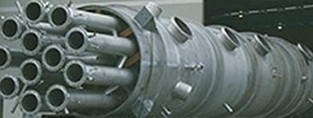
- (03) 5909 8218
- enquiry@fusionweld.com.au
Pressure Vessels and Fabrication Services: Factors to Consider in Design and Manufacture
November 3, 2017

Let's pull back from the exhaustively conducted manufacturing sequences that were carried out during the fabrication of a high-functioning pressure vessel. That's right, instead of scrutinizing the continuity of a sheet metal container or repeatedly inspecting the integrity of weld seam for the umpteenth time, the goal today is to consider the factors that guide the design and manufacturing process. It's all about the fabrication services, right?
Fabrication Services: The Underlying Principles
Function dovetails cordially with safety when the design and manufacturing factors are properly evaluated. Treated as a logistical issue, the process hangs the parts and services on a frame built from the OSHA guidelines. Directed by these codes and other process-relevant regulations, pressure vessels are built to meet the parameters of a specific operational setting. Whether that installation platform is designed to store a stated fluid or to act as a key component in a processing chain, it is imperative that the containment unit safely confines every drop and vapour wisp of this potentially hazardous fluid medium. Incidentally, even if that medium is water, there are weighty parameters to deal with here, including the high temperatures and hard to confine pressures that will transform that normally inert fluid into a dangerously energetic resource.
The Three Technology Paradigm
Take away the pressure vessel an all of the ancillary components, including the system-protecting safety valves and process monitoring instrumentation. These are the framing components that couple mathematically with the manufacturing procedures to form the outlines of the pressure vessel, but they belong almost wholly in the design half of this processing strategy. Manufacturing methodologies employ these parts and design elements as shaping and modelling tools, but it's the three-part fabrication triangle that produces the final product. In order of importance, that chain of manufacturing activity begins with machining, then it proceeds through the welding stage, before concluding at the assembly and inspection phase. Of course, several factors orbit this central processing nexus. They include the work hardening stage, the non-destructive testing phase, and the material usage proposal.
There's connective tissue tethering all of these fabrication services. They're formed by the ASME and OSHA codes. As for the important factors to consider in pressure vessel design and manufacturing, every one of those production elements binds one operation to the next. Design acuity highlights vessel geometry and material selection. Machining stations take their cues from design drawings and material types so that every conceivable tooling requirement is satisfied. Finally, the installation platform accepts the finished product, but only if that pressure vessel has been fabricated to comply with these logistically compiled design and manufacturing factors.
Contact Details
Fusion - Weld Engineering Pty Ltd
ABN 98 068 987619
1865 Frankston Flinders Road,
Hastings, VIC 3915
Ph: (03) 5909 8218
Optimized by NetwizardSEO.com.au
Recent Posts
- Compressed Hydrogen Storage Vessels: Material Selection, Design & Australian Standards
- Welding QA/QC in Oil & Gas Pressure Vessel Fabrication – Ensuring Code Compliance
- AS1210 vs ASME VIII Pressure Vessel Code: Key Differences for Australian Projects
- Mitigating Hydrogen-Induced Cracking in Pressure Vessels: Engineering and Material Strategies
- Storage Tank Solutions Australia: Field-Erected, Prefabricated & Self-Bunded Explained
- Reducing Environmental Risks: Self-Bunded Tanks in Australian Oil & Gas Operations
- Precision in Production: How Pressure Vessels Are Manufactured for Industrial Safety
- Shell & Tube Heat Exchangers: Improve Thermal Control & Energy Recovery in Petrochemical & Pharmaceutical Plants
- In-Service Inspection for Compressed Air Receivers for Power Plant Shutdown Prevention
- Power Plant Pipe Spooling Fabrication – Get Rapid, Code-Compliant Spools Ready for Installation
- Field Erected Tanks: Safe, Reliable On-Site Fuel Storage Solutions in Australia
- Custom Pressure Vessel Fabrication for Flammable Gases
Posts 2025
- Compressed Hydrogen Storage Vessels: Material Selection, Design & Australian Standards
- Welding QA/QC in Oil & Gas Pressure Vessel Fabrication – Ensuring Code Compliance
- View all articles…
Posts 2024
- Large Process Vessels: Optimising the Design for Maximum Efficiency [2025]
- Pressure Equipment Management System Installation: Detect Equipment Faults Early
- View all articles…
Posts 2023
- Pressure Piping System Inspection: A Gift of Safety for the Holidays
- Deaerator Inspections by Fusion-Weld Engineering and How They Reduce System Downtime
- View all articles…
Posts 2022
- How Fusion Weld Keeps Up With AS-NZS ISO 9001:2008 Standard
- Boiler Equipment Safety Inspection During the Summer Season
- View all articles…
Posts 2021
- Avoid These Factors and Practices that Contribute to Sealing Damage in Pressure Vessels
- Do's And Don'ts Of Industrial Boiler Inspection And Maintenance From Fusion-Weld
- View all articles…
Posts 2020
- What are the Risks and Hazards Involved in Pressure Vessel Equipment?
- How to Know if Your Pressure Equipment Needs Repair or Replacement?
- View all articles…
Posts 2019
- Factors that Contribute to Pressure Vessel Failure
- Pressure Vessel Regulations in Australia: What are the Mandatory Requirements?
- View all articles…
Posts 2018
- Pros and Cons of Spherical vs. Cylindrical Pressure Vessels
- What are the Different Hazard Levels in Pressure Vessels?
- View all articles…
Posts 2017
- Transportable Pressure Vessels: The Importance of Inspection and Safety Checks
- Fracture Mechanics and Stress Analysis of Cracks in Pressure Vessels
- View all articles…
Posts 2016
Posts 2015
- What Are Deaerators & Feedwater Vessels?
- Precautions and Safety for Compressed Air Receiver Vessels
- View all articles…
Posts 2014
- Demonstrating In-process Inspection Procedures
- Static Grounding Practices and Standards
- View all articles…